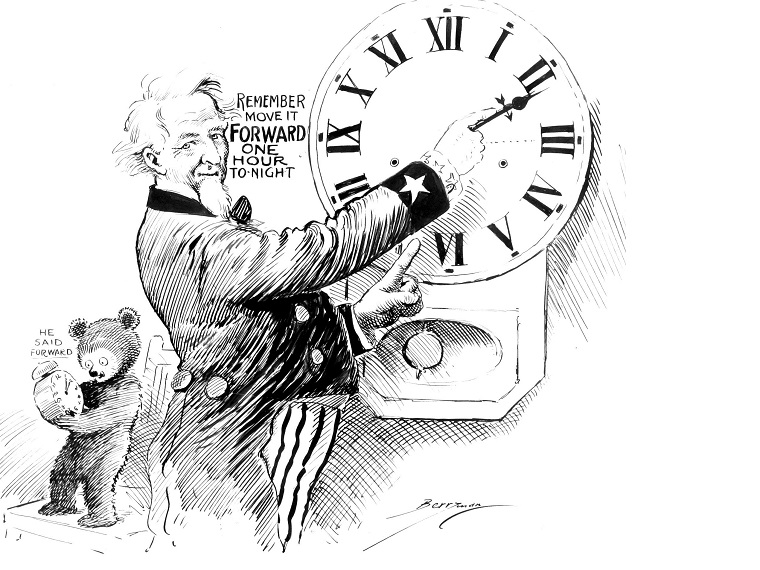Daylight Saving Time (DST) changes the official time. The result is we wake up an hour earlier during the summer months.
As an illustration, without DST, sunrise this June 19 would be at 4:15 a.m. in Chicago and sunset at 7:29 p.m. With DST, sunrise will be at the more reasonable hour of 5:15 a.m., sunset at 8:29 p.m., and kids can play outside well into the evening.
Benjamin Franklin is often credited with first proposing Daylight Saving Time to save candles. During World War I, Germany started DST in 1916 to save energy. Its European foes and allies soon followed.
The United States first instituted Daylight Saving Time in 1918, the same year it officially adopted Standard Time, the subject of my previous post. In sharp contrast to the rapid 1883 voluntary adoption of Standard Time, the adoption of DST was very slow and far from uniform. Resistance was particularly fierce in rural areas.
Chicago has been much more enthusiastic, with 353,145 voting for and 291,994 against adopting DST in 1920. Daylight Saving for Chicago, an election pamphlet, promotes the increased outdoor recreation possibilities. Even in discussing the pitfalls, it is upbeat, saying:
It is a simple matter to remember that "official" time during the seven months period, is one hour ahead of train time (Central Standard Time). One who forgets will not miss his train--he will just be an hour early.
Opposition to DST came from all sides according to Keeping Watch. Moralists did not like the extra leisure time after work. Late-night people thought it was a plot by moralists and morning people to make them observe Benjamin Franklin’s maxim: "Early to bed and early to rise, makes a man healthy, wealthy and wise." Farmers reasoned that the hired help would continue to rise with the sun, but insist on knocking off work an hour early like their city cousins. It has been argued that DST saves energy, that it doesn’t save energy and that it causes accidents and heart attacks.
Below is a brief history of when Chicago has observed Daylight Saving Time. Information for the rest of the country can be found in the The American Atlas, a book intended to aid astrologers in constructing accurate birth charts.
- 1918, 1919: By national law, DST lasted from the last Sunday in March to the last Sunday in October.
- 1920: No DST. Congress repealed DST despite a presidential veto and the votes of the entire Chicago delegation in favor.
- 1921-1940: Chicago decided by both popular vote and by a vote of the City Council to observe DST from the last Sunday of April to the last Sunday of September. Chicago suburbs also observed Chicago time.
- 1941: DST was extended by ordinance so it lasted from the last Sunday of April to the last Sunday of October.
- February 9, 1942 to September 30, 1945: Chicago and the nation observed National War Time, which was the same as year-round Daylight Saving Time. Chicago, unlike every other part of the country, continued to observe Daylight Saving Time until the last Sunday of October 1945.
- 1946-1966: Chicago resumed observing DST from the last Sunday of April to the last Sunday of October. Elsewhere in the country, some cities and states observed DST, some did not. Different places also started and ended in different months. For example, cities in Missouri followed 11 different DST schedules.
- 1967-1973: The Uniform Time Act of 1966 put the entire country on Chicago’s schedule of DST from April to October. An ever-changing lineup of states and parts of states continued to opt out of DST.
- 1974, 1975: In the wake of the oil crisis, the federal Emergency Daylight Time Act extended DST from January 6 to October 27, 1974 and February 23 to October 26, 1975.
- 1976-1986: Resumed DST from the last Sunday of April to the last Sunday of October.
- 1987-2006: Federal law changed DST so it is from the first Sunday of April to the last Sunday of October.
- 2007 to present: Reportedly, in response to lobbying by the golf and barbecue industries, Congress changed DST so it now lasts from the second Sunday of March to the first Sunday of November. This also allows trick-or-treaters to go around in daylight. I’ll note that when I was a kid, it was considered rude to trick-or-treat before dark. By 2007, 89 years after it started, Daylight Saving Time was observed by all states except Hawaii and Arizona.
For more information on the history of timekeeping, please consult my Daylight Saving Time booklist.




Add a comment to: Daylight Saving Time in Chicago